People make purchase decisions based on more than just price and product quality.
Knowing the psychological triggers that cause people to buy — or not to buy — can give you an edge over your competitors when it comes to gaining new customers and increasing sales.
By understanding the psychological biases that influence sales decisions, you can create effective marketing campaigns that capitalise on your prospects’ natural tendencies and encourage them to take action.
In this article, we’ll explore 13 of the most powerful psychological biases that marketers (and business owners) should be aware of when crafting their messages.
By applying these principles, you can create a marketing strategy to help you stand out from the crowd and convert more leads into sales.

1. The Bandwagon Effect
People are more likely to buy something if they think everyone else is doing it.
This is based on the idea that people are likely to participate in a phenomenon or believe something to be true if they think it has widespread approval and acceptance.
For example, this can be seen when we look at social media phenomena like the “ice bucket challenge“.
This example perfectly illustrates social proof, which is an essential part of the Bandwagon Effect. People were encouraged to participate by creating videos of themselves taking part and even tagging their friends to join in.
It’s believed that this viral effect was due mainly to social proof, where people felt pressured to keep up with their peers and not appear to be left out.
As more people jumped on board, the pressure increased, and news of the ice bucket challenge spread quickly throughout the internet.
This kind of bandwagon effect has been leveraged by many brands for marketing purposes as well — because we humans often prefer choosing what is popular rather than making individual decisions.

2. The Scarcity Bias (FOMO)
The scarcity bias is an important concept to understand when it comes to marketing.
This is the fear that if someone doesn’t act quickly, they will miss out on a “great opportunity” (a.k.a. FOMO or fear of missing out).
An example would be the introduction of Apple products such as iPhones, iPads and Macbooks.
When these products first hit the market, they instantly became popular, and everybody was wanting them.
With ingenious marketing and the power of word-of-mouth, Apple generated a sense of FOMO among its customers who wanted to be part of the hype.
This cultivated an atmosphere where everyone feared they would miss out on something special if they didn’t act fast.
Though this example has deeper levels of psychological phenomena at play (fads and the sense of importance), the general use of FOMO is a huge driving factor.
By presenting potential buyers with information on limited-time offers, low stock levels, or one-time-only deals, digital marketing experts can exploit the scarcity bias to get them to act quickly before they miss out on an opportunity.
This strategy has proven very effective, as people instinctively prioritise immediate needs over possible future rewards when resources are limited.

3. The Authority Bias
The Authority Bias applies to marketing by using testimonials and endorsements from authorities to promote a product or service.
This type of bias is based on the idea that people are more likely to believe the opinion of an authority figure over others.
Robert Cialdini, a well-renowned psychologist and expert in the field of influence and persuasion, described the Authority Bias as a phenomenon in which individuals are more likely to agree or comply with a request if presented by an authority figure.
This phenomenon is particularly prevalent in marketing as companies rely on advertisements featuring authoritative figures, such as experts or celebrities, to gain the trust of potential customers.
For example, when Hyundai hired actor Ryan Reynolds to appear in a series of commercials promoting their cars, they quickly saw a surge in sales.
This was due to the popularity of Ryan and the attention he was able to draw to their product.
As a result, consumers may choose this particular brand over other brands simply because an authority figure recommends it.
Understanding the importance of authority bias enables marketers to craft messages more effectively to influence decisions, leading to improved sales performance.
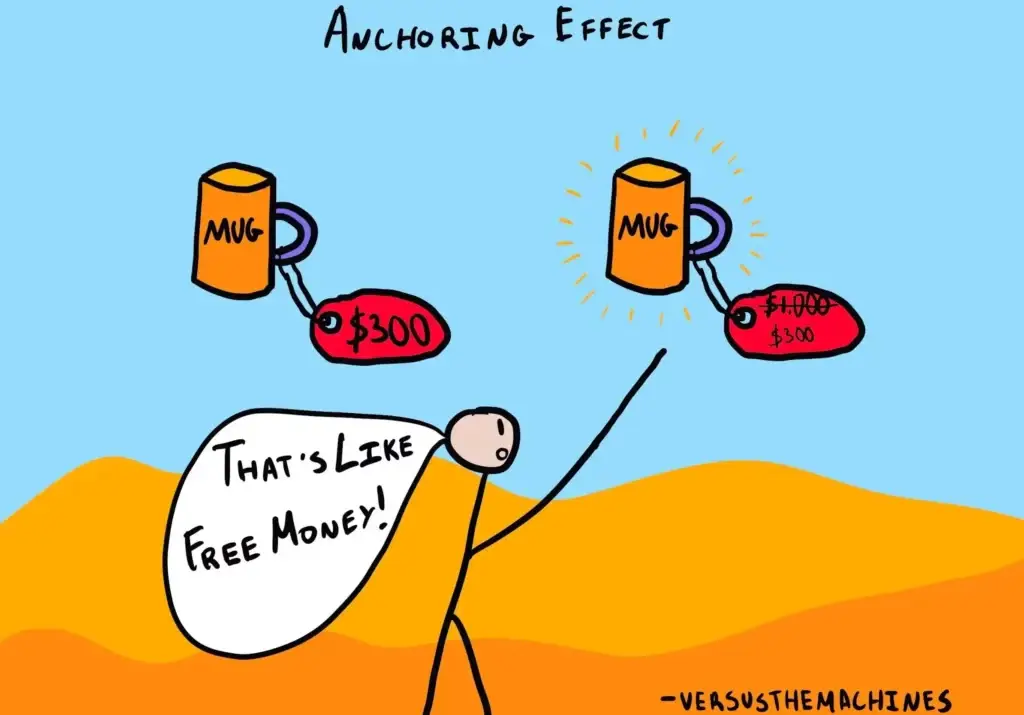
4. The Anchoring Effect (Heuristics)
The anchoring effect states that people tend to rely heavily on the first piece of information they receive when making a decision.
It involves heuristics or cognitive shortcuts — mental shortcuts used to make decisions quickly and easily.
For example, a real estate agent may start by showing potential buyers rundown, unkept properties (a.k.a. “set up properties”) to make the high-end properties they want to show appear more attractive and desirable in comparison.
This ploy gives the buyer the impression that they are getting much more value than what is actually being offered.
This way, using the power of anchoring, businesses can convince customers to pay more than they normally would by providing false starting points.
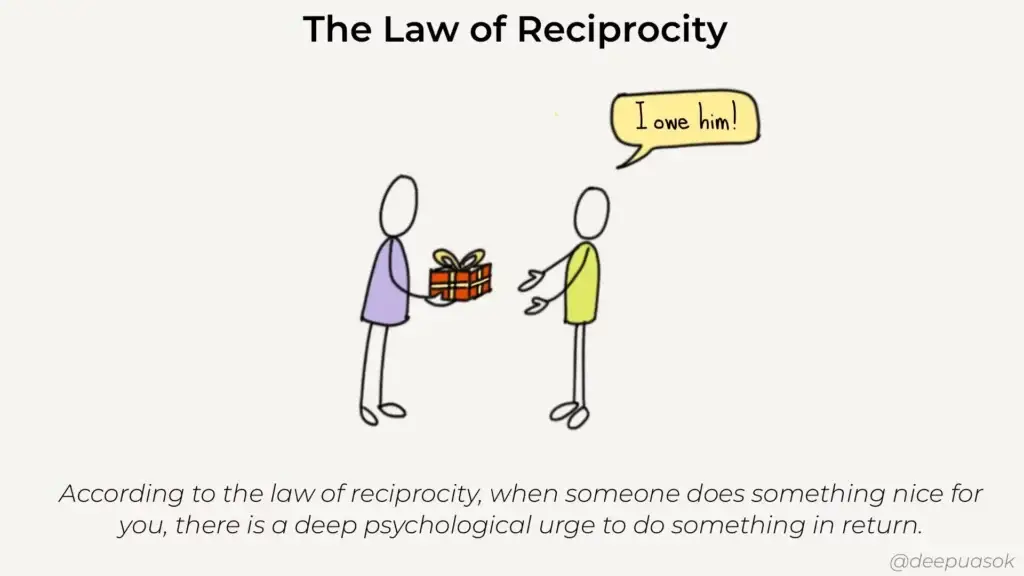
5. The Reciprocity Bias
People feel obligated to return a favour. Put simply, this bias can be thought of as the human tendency to want to reciprocate when someone does something nice or gives you something of value.
For example, if a friend offers to cover your meal when you’re out together, you may find yourself feeling inclined to return the favour at some point.
Marketers can use this bias to make their customers feel obligated to buy their product or service in exchange for the value they provided initially.
By introducing consumers to a product through free samples or discounts, businesses can increase the likelihood of customers ‘paying back’ the favour through purchases.
The Reciprocity Bias is both instinctive and effective – it not only encourages people to give more than they take, but it also serves as an effective way for businesses to market their products and gain customer loyalty.
So, make sure to offer something for free in your marketing campaigns — like a white paper, webinar or e-book — in exchange for an email address or other contact information.
This way, you can give prospects something of value before you ask them to commit to a sale.
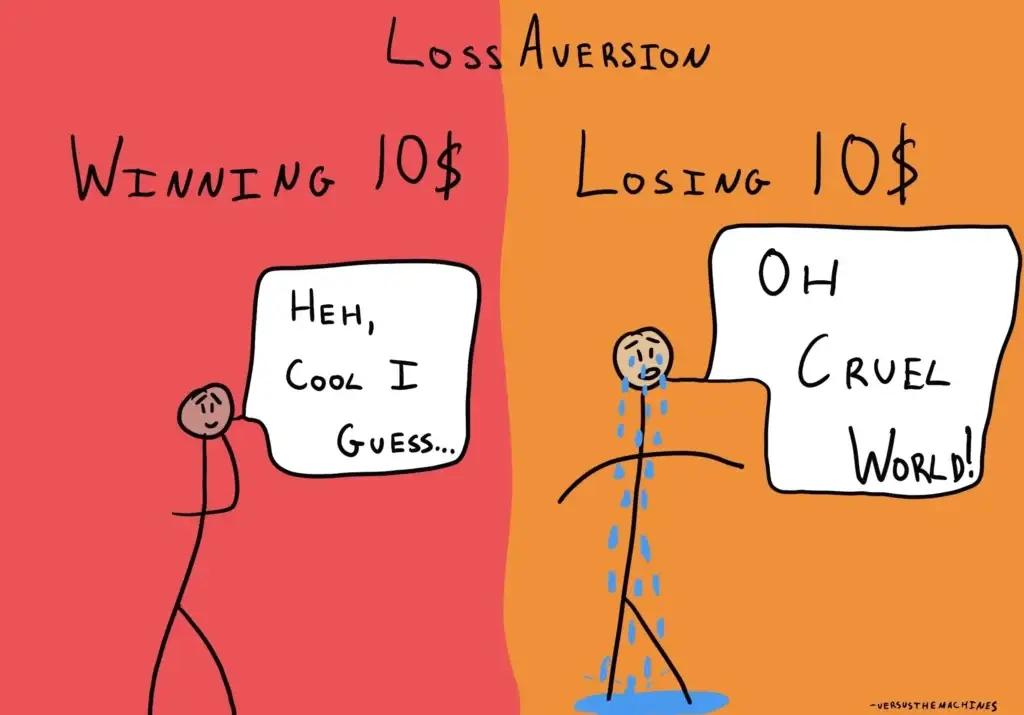
6. The Loss Aversion Bias
The Loss Aversion Bias is an important cognitive phenomenon that describes how human beings have a strong fear of loss.
This fear of loss is shown in that people often feel more motivated to avoid losses than to pursue gains.
A prominent example of this can be seen with buying insurance. People buying insurance tend to focus on the potential costs they will incur should something happen, as opposed to the premiums they are paying out to stay protected against loss.
For example, a company selling car insurance may tell stories about people who lost their cars due to a single claim being too large for them to cover affordably.
Such vivid examples tap into our primal fear of loss and bolster buying decisions.
To ensure the best results when using this bias, marketers should ensure that their claims are transparent and accurate to establish trust with consumers.
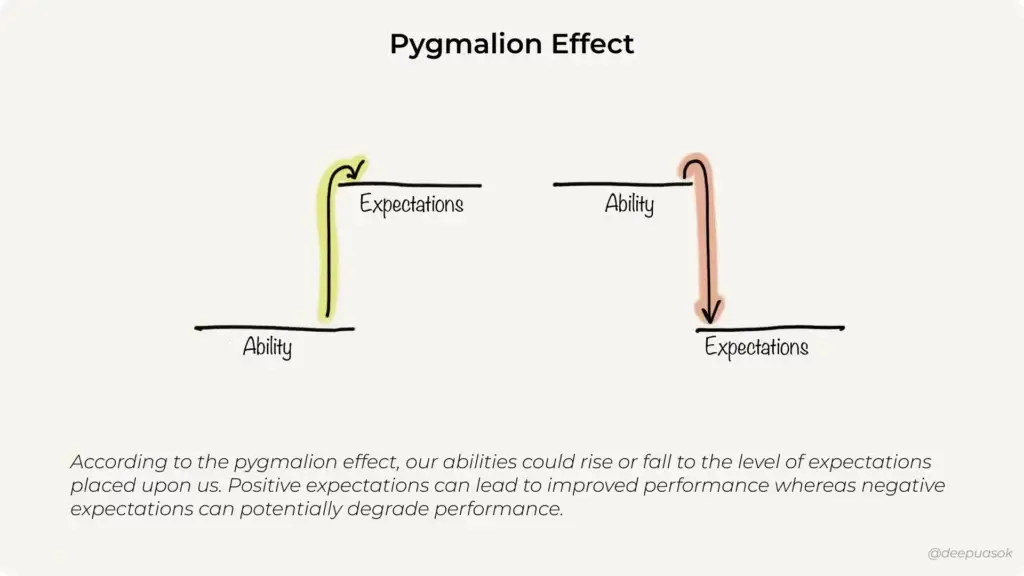
7. The Self-fulfilling Prophecy
The Self-fulfilling Prophecy bias, commonly referred to as the ‘Pygmalion Effect‘, states that our expectation of someone or something could create consequences to make those expectations come true.
This means that if a person believes they are going to fail at something, they are more likely to do poorly despite their best efforts; likewise, if they have a positive outlook, their results are likely to be favourable.
Knowing and understanding this bias can be incredibly important for marketers – when it comes to product research, it’s essential that consumers feel confident in the product and its benefits.
This effect can be helpful and harmful for marketers, as they need to manage high expectations while also being aware of associated risks.
Knowing this bias helps them plan accordingly with strategies like ensuring enough supply and providing clarity around the features and goals of their products. It’s important for marketers to understand this concept so they can make data-driven decisions rooted in realistic projections based on actual evidence.
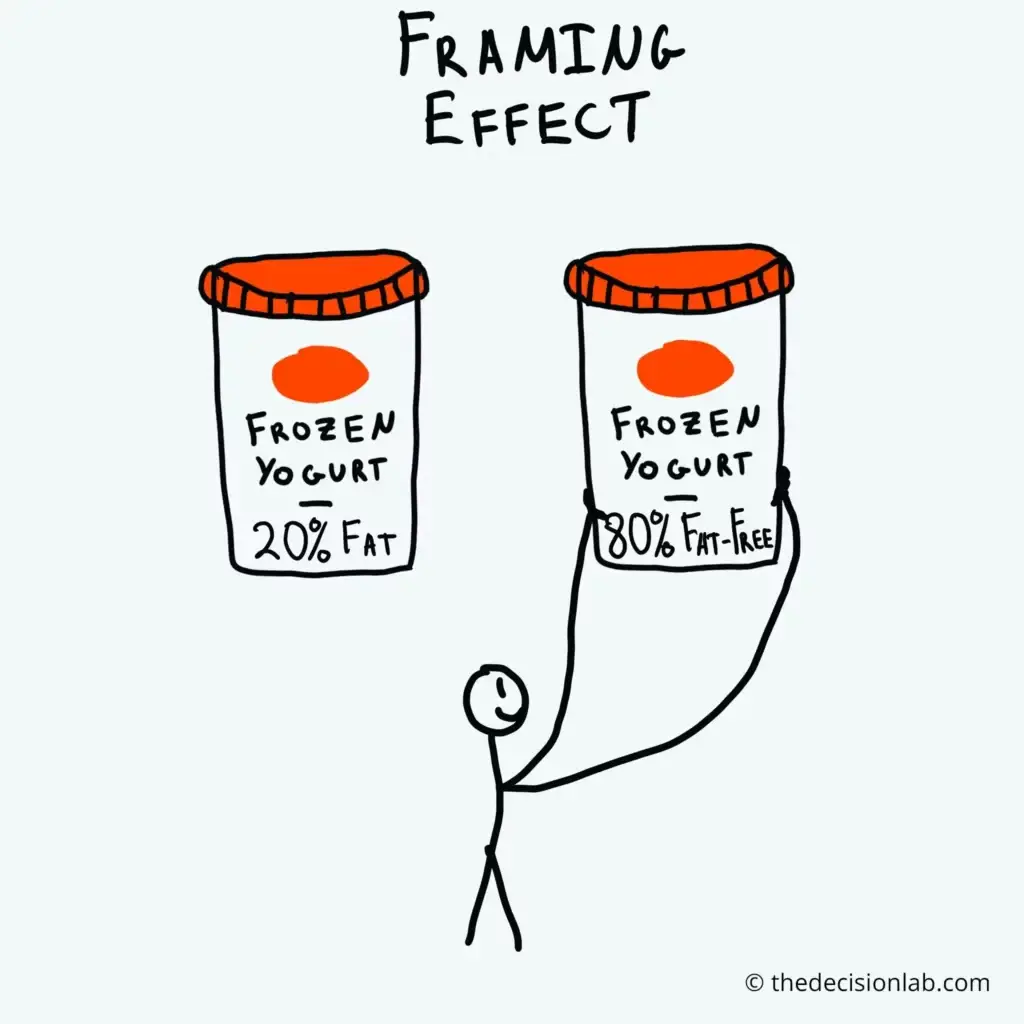
8. The Framing Effect
The Framing Effect is all about how the context of a message affects how consumers interpret it.
For example, if an advertiser presents two different versions of a product but frames them differently (such as saying one version “saves $100 while the other costs $100”), consumers are more likely to select the option framed as saving them money even though they both cost the same.
Using words and images that create positive or negative associations, marketers can position their product to evoke desired emotions from consumers.
By emphasising certain benefits of a product or by choosing pleasant backgrounds for photos and videos, marketers can create an effective “frame” around their message.
This helps to control consumer perception and increase market share. As most marketers already know, understanding consumer behaviour is key to success, so it is important that they keep abreast of the latest trends — such as the Framing Effect — to ensure they are providing messages that have the desired outcome in terms of sales or brand loyalty.
With this in mind, it’s important that marketers pay close attention to the language they use when crafting messages and promotional campaigns because subtle shifts in the frame can make a major difference in response rates.
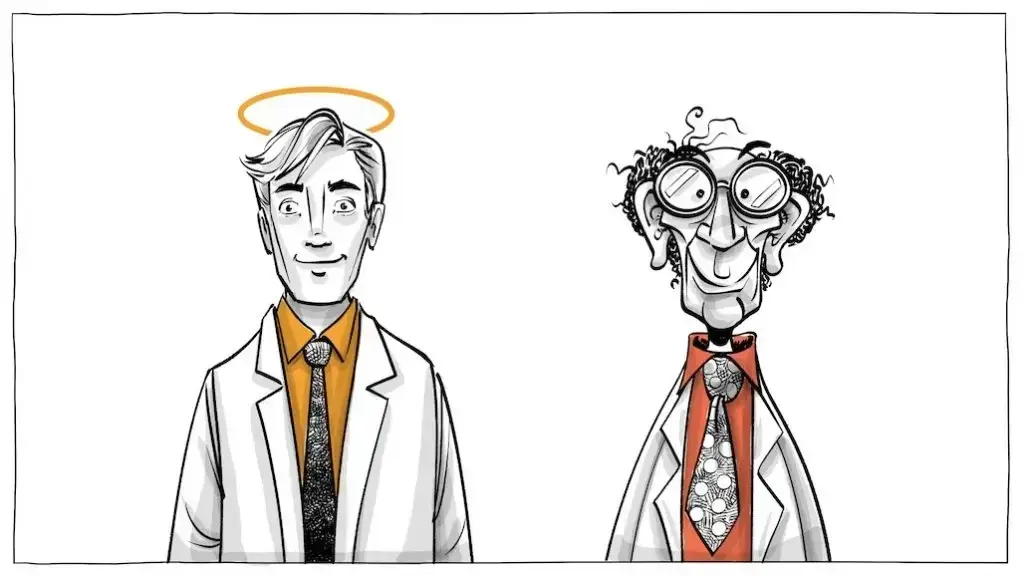
9. The Halo Effect
The Halo Effect is a phenomenon where a consumer’s perception of one product can influence their opinion of the overall brand.
For example, if someone has a bad experience at a restaurant, whether it’s with the food quality or service, they are likely to never return to that restaurant in the future.
Even though they didn’t sample every dish on the menu and weren’t waited on by each server, in their mind, a single experience defined the entire restaurant as a “bad” place to go.
Marketers should be aware of how this plays into how customers view their products, as each associated characteristic can leave a lasting impression that drastically alters whether or not someone becomes a repeat customer.
By understanding and using the Halo Effect, marketers can ensure that all facets of their product are up to par so as not to hinder sales.
The Halo effect is an incredibly important factor that allows marketers to investigate and reduce churn rates.

10. The Attention Bias
Attention bias is the idea that external influences can easily skew our focus of attention. The goal is to direct people’s attention towards a certain product or service instead of another.
Companies do this by emphasising certain product features by making them the focal point of their advertisements.
They use flashy colours and large fonts to draw attention and captivate their audience while ensuring that no other elements detract from the main goal of the ad.
Knowing what drives us to pay attention and take action (positively or negatively) is essential for any marketer who wants to succeed in their industry.
By understanding the psychology behind attention bias, marketers can create effective campaigns focusing on the areas that elicit a positive response from their target audience.
This will help ensure that the consumer’s attention is held and ultimately results in increased sales.
11. The Consistency Bias
The Consistency Bias basically means that people have a strong desire to be consistent with their past actions and decisions.
Notice how I didn’t add an image above? wink–wink*.
It’s our tendency as consumers to prefer consistency. We like to keep things simple, and we’re more likely to continue doing something if it has been successful in the past.
This creates habits that are difficult to break, making the Consistency Bias a powerful tool for marketers striving for success.
An example of this might be listening to the same music all the time, going to the same favourite restaurants often, or always ordering certain items when shopping online.
Knowing how customers consistently make choices can allow marketers to tailor their approaches and advertising messaging based on consumer preferences and behaviour.

12. The Illusion of Control Bias
The Illusion of Control Bias occurs when people believe that they have control over situations where, in reality, chance or luck governs the outcome.
This is seen most clearly in gambling, where gamblers feel responsible for their own luck and results — often overlooking external factors (this crosses into the gambler’s fallacy).
Knowing about this bias is incredibly important for marketers, as it helps them understand how to effectively persuade customers by providing them with options and signals of control to give them the feeling that they have power over their decisions.
Another example of this in marketing can be seen when lottery companies employ tactics such as displaying the lottery jackpot winnings prominently in their advertisements.
By advertising the lottery jackpot so prominently, lottery companies create an illusion where customers think they have control as they believe buying lottery tickets will increase their chances of winning; however, in reality, lottery tickets provide no guarantee.
Lottery companies use this to exploit people’s desire to exert control, often resulting in consumers spending more money than intended.
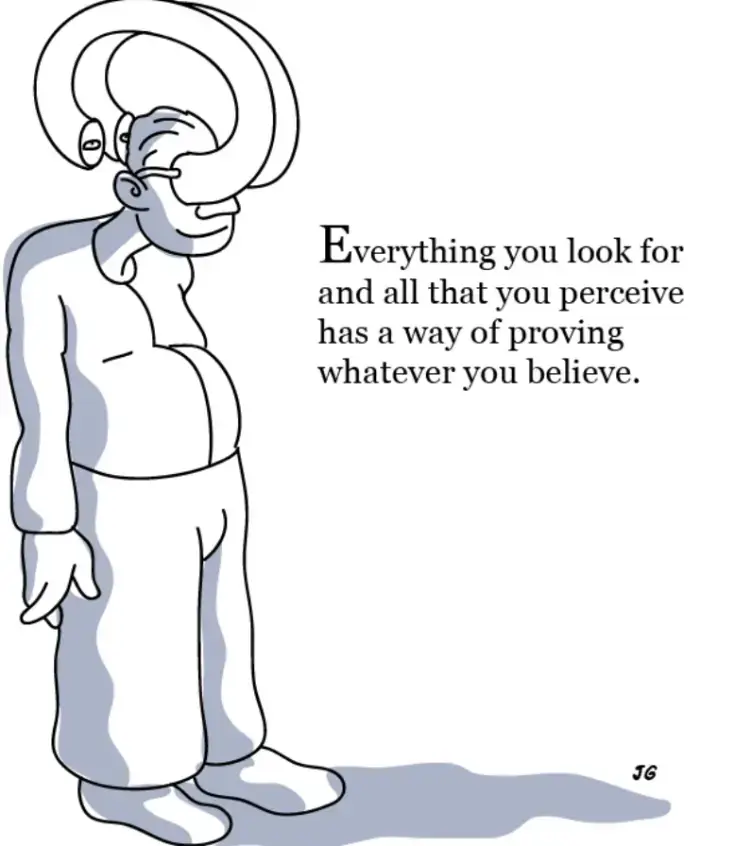
13. The Confirmation Bias
People are more likely to believe information that confirms their existing beliefs. This also causes them to ignore evidence that contradicts their beliefs (no matter if it’s true or not).
A classic example of Confirmation Bias in everyday life is when someone makes a decision based on their personal beliefs and then looks for evidence to back up their opinion.
The person might select the information that supports their view and discard any viewpoints that don’t.
This type of partial reasoning happens more often than most people realise, as it can be hard to truly evaluate an issue objectively or hear another’s point of view without filtering it through our own pre-existing biases.
As a result, we form arguments and conclusions based on limited information, creating an inaccurate picture of reality.
We’ve all seen and heard news outlets, from newspapers to radio to TV channels, showing us stories that confirm what we already believe.
When it comes to news coverage, these outlets know that viewers are likely to respond better when they discuss topics they believe in or agree with.
This manipulation of public opinion is a classic example of Confirmation Bias at work. By confirming people’s preconceived notions, these news publishers can generate more interest among viewers and increase their market share.
For marketers, Confirmation Bias means it’s important to understand what people believe and offer options that confirm those beliefs.
By doing this, you can create a positive feedback loop that strengthens consumer loyalty and generates more sales.
Which bias shocked or inspired you most?
It’s important for marketers to be aware of cognitive biases and how they can affect consumer behaviour.
By understanding the motivations behind consumers’ decisions, you can create more effective marketing campaigns that get the desired results.
From the Anchoring Bias to The Confirmation Bias, understanding these common biases will help you build a better marketing strategy and increase your sales.
However, it’s important to remember that each person is different, so you should always be aware of how these biases may impact the decisions of your target customers.

